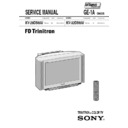Sony KV-28DS65U Service Manual ▷ View online
21
2-1. REAR COVER REMOVAL
2-3. SERVICE POSITION
2-2. CHASSIS ASSY REMOVAL
1
6 Screws
6 Screws
BTV 4x16
2-4. A1 BOARD REMOVAL
SECTION 2
DISASSEMBLY
2
2 Screws
BTV 4x16
BTV 4x16
3 Rear Cover
22
2-5. J BOARD REMOVAL
2-7. D1 BOARD REMOVAL
2-6. B BOARD REMOVAL
2-8. H BRACKET REMOVAL
23
Anode button
a
* REMOVING PROCEDURES.
Turn up one side of the rubber cap in
the direction indicated by the arrow a
the direction indicated by the arrow a
1
2 Using a thumb pull up the rubber cap
firmly in the direction indicated by the
arrow b
firmly in the direction indicated by the
arrow b
3 When one side of the rubber cap is
separated from the anode button, the
anode-cap can be removed by turning
up the rubber cap and pulling it up in
the direction of the arrow c
separated from the anode button, the
anode-cap can be removed by turning
up the rubber cap and pulling it up in
the direction of the arrow c
b
b
c
Note : Short circuit the anode of the picture tube and the anode cap to the metal chassis, CRT shield or carbon paint on the CRT, after removing the anode.
• REMOVAL OF ANODE-CAP
•
HOW TO HANDLE THE ANODE-CAP
1
To prevent damaging the surface of the anode-cap do not use sharp materials.
2
Do not apply too great a pressure on the rubber, as this may cause damage to
the anode connector.
the anode connector.
3
A metal fitting called a shatter hook terminal is fitted inside the rubber cap.
Do not turn the rubber foot over excessively this may cause damage if the
shatter hook sticks out.
Do not turn the rubber foot over excessively this may cause damage if the
shatter hook sticks out.
Cushion
2-9. PICTURE TUBE REMOVAL
7 DGC holder
Picture tube 11
C board 3
Spring tension 9
Degaussing coils 8
Anode cap 1
Neck assy 5
VM board 4
Deflection yolk 6
2 Chassis assy
10 Four PT screws
24
•
When complete readjustment is necessary or a new
picture tube is installed, carry out the following
adjustments.
picture tube is installed, carry out the following
adjustments.
•
Unless there are specific instructions to the contrary,
carry out these adjustments with the rated power supply.
carry out these adjustments with the rated power supply.
•
Unless there are specific instructions to the contrary, set the
controls and switches to the following settings:
controls and switches to the following settings:
Contrast
...............
normal
Brightness
...............
normal
Carry out the following adjustments in this order:
3-1.
Beam Landing
3-2.
Convergence
3-3.
Focus
3-4.
White balance
Note:
Test equipment required
1.
1.
Color bar/pattern generator.
2.
Degausser.
3.
Digital multimeter.
4.
Oscilloscope.
SECTION 3
SET-UP ADJUSTMENTS
3-1. BEAM LANDING
Preparation:
1.
In order to reduce the influence of geomagnetism on the set’s
picture tube, face it in an easterly or westerly direction.
picture tube, face it in an easterly or westerly direction.
2.
Switch on the set’s power and degauss with the
degausser.
degausser.
(1)
Adjustment of Correction Magnet for Y-Splitting
Axis
Axis
1.
Input a crosshatch signal from the pattern generator.
2.
Set the Picture control to minimum and confirm that the
Brightness control is set to normal.
Brightness control is set to normal.
3.
Position the neck assembly as indicated in Fig.3-2.
4.
Move the deflection yolk as far forward as is possible.
5.
Adjust the upper and lower pin symmetrically by opening or
closing the Y-splitting axis correction magnets located on the
neck assembly.
closing the Y-splitting axis correction magnets located on the
neck assembly.
6.
Return the deflection yolk to its original position.
Caution :
High voltages are present on the Deflection yolk terminals - take
care when handling the Deflection yolk whilst carrying out
adjustments.
care when handling the Deflection yolk whilst carrying out
adjustments.
(2) Landing
Note :Before carrying out the following adjustments
adjust the magnets as indicated below [See Fig.3-3].
1.
Input an all-white signal from the pattern generator.
Maximize the picture setting and adjust the Brightness
setting.
Maximize the picture setting and adjust the Brightness
setting.
2.
Rough-adjust the focus and horizontal convergence.
3.
Loosen the deflection yolk screws and align the purity
adjustment knob to its central position. [See Fig.3-1].
adjustment knob to its central position. [See Fig.3-1].
4.
Switch from the all-white pattern to an all-green pattern.
5.
Move the deflection yolk backwards and adjust with the
purity magnet so that the green is at the centre and it aligns
symmetrically. [See Fig.3-4].
purity magnet so that the green is at the centre and it aligns
symmetrically. [See Fig.3-4].
6.
Move the deflection yolk forward and adjust so that the
entire screen becomes green.
entire screen becomes green.
7.
Switch the raster signal to red, then to blue and verify the
landing condition.
landing condition.
8.
When the position of the deflection yolk has been deter-
mined, fasten the deflection yolk with the screw.
mined, fasten the deflection yolk with the screw.
9.
If the beam does not land correctly in all the corners of the
screen, use magnets to correct it. [See Fig.3-5].
screen, use magnets to correct it. [See Fig.3-5].
Y-splitting axis correction magnet
Fig.3-1
Fig.3-2
Purity
Align Pips
on each
magnet
on each
magnet
Neck assy
Align the bottom edge
of the neck assy with
the G3 hole centre.
of the neck assy with
the G3 hole centre.
Deflection yoke
Fig.3-3
Click on the first or last page to see other KV-28DS65U service manuals if exist.

